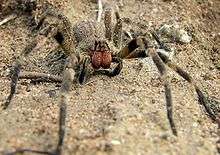Wandering spider
| Wandering spiders | |
|---|---|
 | |
| Phoneutria nigriventer | |
| Scientific classification | |
| Kingdom: | Animalia |
| Phylum: | Arthropoda |
| Subphylum: | Chelicerata |
| Class: | Arachnida |
| Order: | Araneae |
| Infraorder: | Araneomorphae |
| Family: | Ctenidae Keyserling, 1877[1] |
| Genera | |
|
see text | |
| Diversity[2] | |
| 41 genera, 503 species | |
 | |
The wandering spiders are the members of the spider family Ctenidae. Some mistakenly misinterpret the name to only mean the genus Phoneutria, which are often called Brazilian wandering spiders (despite several species with ranges outside Brazil), but wandering spiders better refers to the entire family Ctenidae. Some members of the genus Phoneutria are highly defensive[3] and venomous nocturnal hunters, and are the only wandering spiders known to pose potential danger to humans. However, the venoms of many other members of this family are very poorly known,[4] meaning that all larger ctenids should be treated with caution. Some ctenids have marks and patterns that are attractive. Ctenids have a distinctive longitudinal groove on the top-rear of their oval carapace[5] (some other spiders have a similar groove; e.g., Amaurobiidae).
Genera
As of March 2017, the World Spider Catalog accepted the following genera:[1]
- Acantheis Thorell, 1891
- Acanthoctenus Keyserling, 1877
- Africactenus Hyatt, 1954
- Afroneutria Polotow & Jocqué, 2015
- Amauropelma Raven, Stumkat & Gray, 2001
- Anahita Karsch, 1879
- Ancylometes Bertkau, 1880
- Apolania Simon, 1898
- Arctenus Polotow & Jocqué, 2014
- Asthenoctenus Simon, 1897
- Bengalla Gray & Thompson, 2001
- Califorctenus Jiménez, Berrian, Polotow & Palacios-Cardiel, 2017
- Caloctenus Keyserling, 1877
- Celaetycheus Simon, 1897
- Centroctenus Mello-Leitão, 1929
- Chococtenus Dupérré, 2015
- Ciba Bloom et al., 2014
- Ctenus Walckenaer, 1805
- Cupiennius Simon, 1891
- Diallomus Simon, 1897
- Enoploctenus Simon, 1897
- Gephyroctenus Mello-Leitão, 1936
- Incasoctenus Mello-Leitão, 1942
- Isoctenus Bertkau, 1880
- Janusia Gray, 1973
- Leptoctenus L. Koch, 1878
- Mahafalytenus Silva, 2007
- Montescueia Carcavallo & Martínez, 1961
- Nothroctenus Badcock, 1932
- Ohvida Polotow & Brescovit, 2009
- Parabatinga Polotow & Brescovit, 2009
- Petaloctenus Jocqué & Steyn, 1997
- Phoneutria Perty, 1833
- Phymatoctenus Simon, 1897
- Sinoctenus Marusik, Zhang & Omelko, 2012
- Thoriosa Simon, 1910
- Toca Polotow & Brescovit, 2009
- Trogloctenus Lessert, 1935
- Trujillina Bryant, 1948
- Tuticanus Simon, 1897
- Viracucha Lehtinen, 1967
- Wiedenmeyeria Schenkel, 1953
See also
References
- 1 2 "Family: Ctenidae Keyserling, 1877 (genus list)". World Spider Catalog. Natural History Museum Bern. Retrieved 2015-11-10.
- ↑ "Currently valid spider genera and species". World Spider Catalog. Natural History Museum Bern. Retrieved 2015-11-10.
- ↑ Bücherl, Wolfgang; Buckley, Eleanor E. (2013). Venomous Animals and Their Venoms: Venomous Invertebrates. Elsevier. p. 237. ISBN 978-1-4832-6289-5.
- ↑ Okamoto et al. (2009). Ctenus medius and Phoneutria nigriventer spiders venoms share noxious proinflammatory activities. J. Med. Entomol. 46(1): 58-66
- ↑ . McGavin, George C. (2002). Insects and Other Terrestrial Arthropods. New York: Dorling Kindersley Ltd. p. 230. ISBN 0-7894-9392-6.
External links
| Wikispecies has information related to Ctenidae |
| Wikimedia Commons has media related to Ctenidae. |